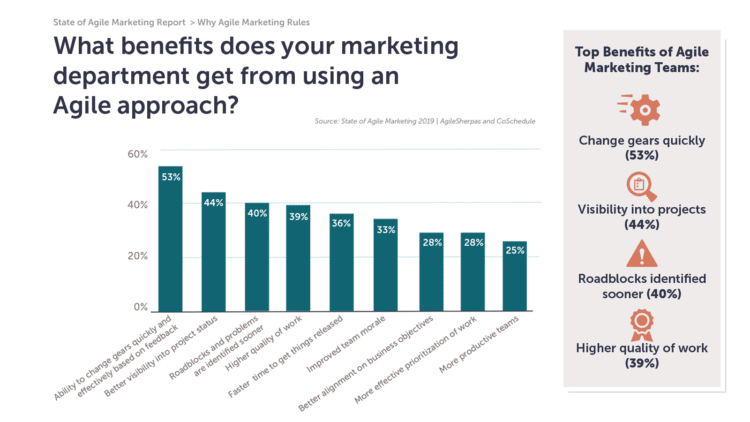
Benefits of Agile Marketing: Stats You Need to Know
Revised with new data April 2019.
If you’re considering an Agile marketing rollout, you’re probably agonizing over the choice between what is right and what is easy.
Maintaining the status quo can seem easy; in fact a belief that current marketing operations are working “well enough” is the second most commonly cited barrier to marketing agility.
Making the right choice, the Agile choice, is often tough.
It’s tempting to fall back into our old ways, to put on a command-and-control attitude just this once to get stuff done, or to spend weeks planning our next project so we can be sure it will turn out just right.
Or maybe you’re sold on the power of Agile marketing, but you need a little help convincing a boss or teammate that change will ultimately be worth it.
To help you (and/or your colleagues) make the right choice, we present this solid, data-driven collection of the benefits of Agile marketing.
Bookmark this page if you need to, and come on back the next time you’re tempted to listen to that anti-Agile devil on your shoulder.
Here are a few general agile marketing benefits to get us started:
- 98% of organizations say they’ve experienced success with an Agile project. (VersionOne)
- 53% of Agile marketing teams are able to change gears quickly based on incoming feedback. (AgileSherpas/CoSchedule)
- Agile projects are twice as likely to succeed as projects run with traditional project management, (Standish Chaos Report)
Looking for something more specific? Let’s check it out.
Agile Marketing is Fast
Let’s go ahead and get this one out of the way first. Everybody associates agility with speed, and the data supports this connection.
- 36% of Agile marketing teams can release things faster, and 53% can change gears quickly when feedback demands it. (AgileSherpas/CoSchedule)
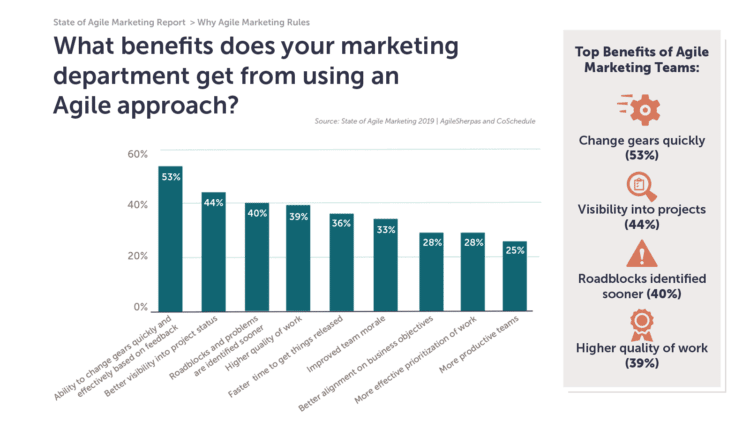
- Agile gets marketing campaigns into the market faster, say 27% of marketing leaders. (Aprimo/Forbes)
- 93% of CMOs who employ Agile practices say their speed to market for ideas, campaigns, and products has improved. (Forbes/CMG Partners)
- More projects are completed on time following the switch to Agile marketing, say 28% of senior marketers. (Aprimo/Forbes)
-
93% of Agile CMOs say they can switch gears more quickly & more effectively.
Marketing Agility Increases Marketing Efficiency
Ok, now that we’ve proven that whole speed thing, let’s talk about the juicier bits: Agile marketers do the right work at the right time.
Because let’s face it, just producing more mediocre campaigns isn’t anybody’s objective.
Instead, we employ marketing agility to help us adjust and adapt to incoming data in a timely, meaningful way. We want to escape from fire drill mode entirely, not just be better fire fighters.
So let’s see what the data has to say about the potential to achieve these lofty ambitions.
- 28% of Agile marketers say they can more effectively prioritize their work in an Agile environment. Another 25% tell us they’re simply more productive with Agile (AgileSherpas/CoSchedule)
- 21% of senior marketers enjoy more efficient marketing iterations once they’re Agile. (Aprimo/Forbes)
- Agile has reduced the number of approvals needed to get work out the door, say 16% of marketers surveyed. (Aprimo/Forbes)
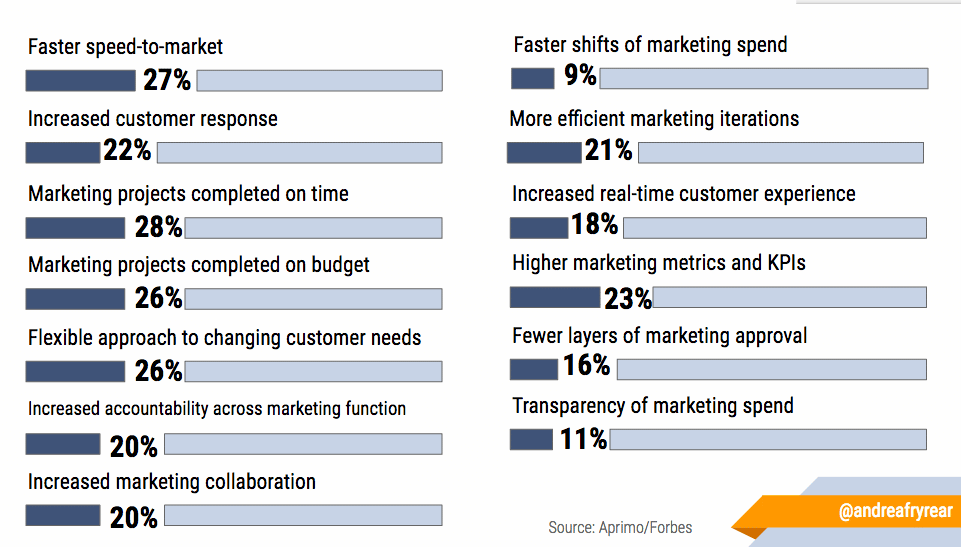
- Agile marketing teams are more responsive to customers. 80% of CMOs said making the switch to Agile helped them deliver a better product that’s more relevant to their end user. (Forbes/CMG Partners)
- Likewise, 26% of senior Agile marketers say they now have a more flexible approach to changing customer needs. (Aprimo/Forbes)
- This is all vitally important, because almost half of most marketers’ daily priorities shift based on what’s in their email inbox (MarketingProfs)
Agile Marketing Teams are Happier
It’s not just output that skyrockets when teams become more Agile.
The individuals on those teams become more satisfied, loyal, and innovative. Agile marketers engage more in their work because they have control over it.
- 87% of Agile CMOs have found their teams to be more productive following the transition to Agile marketing. (Forbes/CMG Partners)
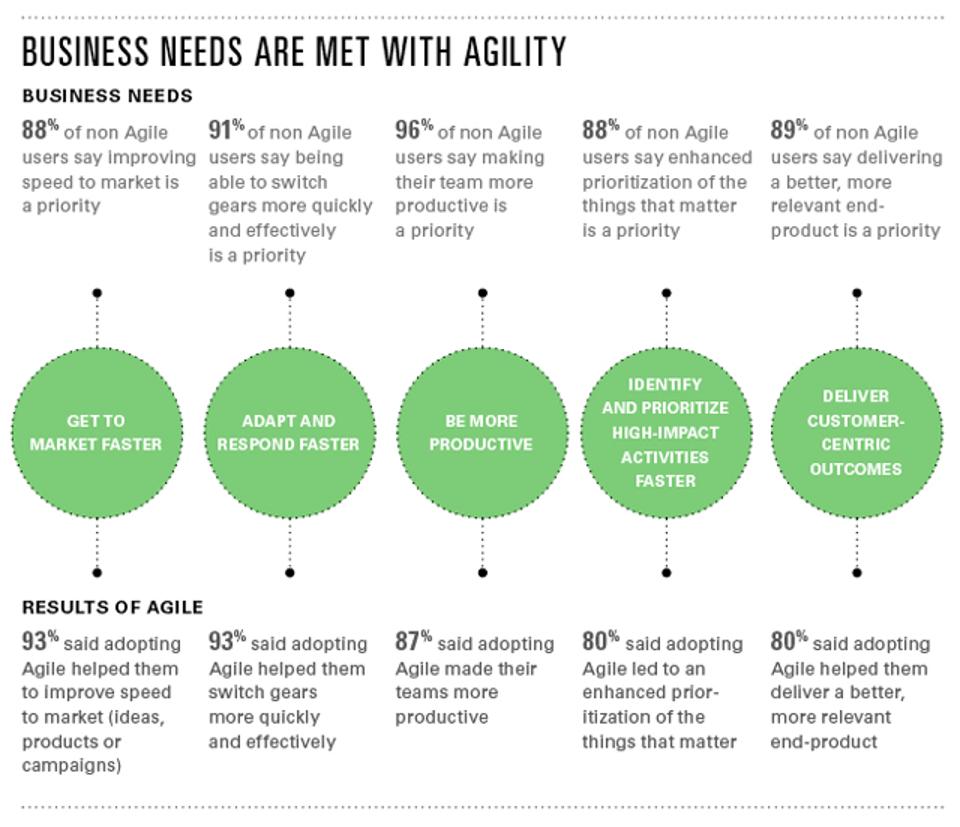
- 33% of Agile marketing teams report improvement in team morale following an Agile transformation. (AgileSherpas/CoSchedule)
- Likewise, 58% of Agile marketers say they’re satisfied or very satisfied with how their teams manage work, while only 32% of marketers who use an ad hoc approach to work management say the same. (AgileSherpas/CoSchedule)
- On the flip side, ad hoc marketing teams are twice as likely to be dissatisfied with their work management as Agile marketers. (AgileSherpas/CoSchedule)
Agile marketing can transform your marketing department, making it easier to build and maintain a team that makes marketing magic.
But remember, it works the other way too.
We’re all creatures of the system we find ourselves embedded in; even if you pull together the world’s most amazing marketing team, they can still fail spectacularly if your work management methodology hamstrings their efforts.
In case you need a reminder about what it’s like to be a marketer on a traditional marketing team, let’s take a quick look at some anti-Agile stats:
- 80% of marketers report that their departments are understaffed, making them feel overloaded. (Workfront Marketers’ Stress Report)
- 53% of marketers say “no” to projects never or just a few times a year, while another 26% simply don’t have the authority to say “no” at all (MarketingProfs)
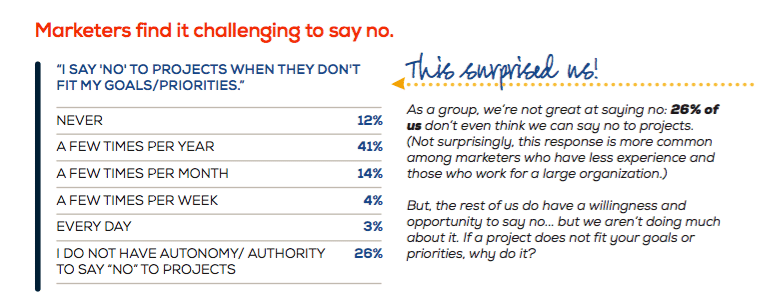
- 1 out of 4 marketers say they’re “overly stressed” or “stressed to the max.” (Workfront)
- Less than half of marketers limit the projects they’re working on so they can spend more time on what matters. (MarketingProfs)
So who do you think will deliver better, more impactful marketing materials? The collaborative, engaged Agile marketers, or the traditional marketers who are stressed to the max and overloaded?
Everybody Knows What Agile Marketing Teams are Up To
We’ve all had those awkward lunch room conversations — the ones where someone from another department is asking about what you’ve been doing, but it’s clear they have absolutely no idea what marketing is up to.
Working under a veil of secrecy may seem nice at times, but when it’s time to allocate annual budget you don’t want people wondering, “What on earth did marketing even do last year?”
Fortunately, Agile marketing’s focus on visibility helps alleviate this problem.
- 20% of senior marketers saw an increase in accountability across the marketing function once they became Agile. (Aprimo/Forbes)
- In the same study, 11% enjoyed more transparency about where they were spending their money once they had shifted to an Agile approach. (Aprimo/Forbes)
- Better visibility into project status is the second most commonly cited benefit of Agile marketing, with 44% of Agile marketers saying they reap this benefit (AgileSherpas/CoSchedule)
- Visibility leads to early detection too, with 40% of Agile marketing teams saying they can now identify roadblocks and problems sooner. (AgileSherpas/CoSchedule)
Agile Benefits from Outside of Marketing
Before we move on to talking about how you can start reaping some of these benefits, let’s take a peek outside the marketing world. Here we see benefits reported in VersionOne’s annual State of Agile survey:
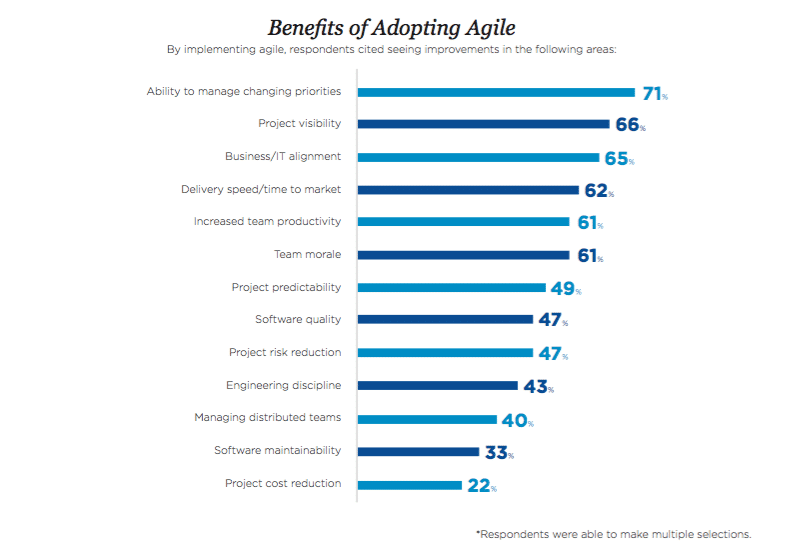
The primary benefits, manage changing priorities, team productivity, and project visibility, have stayed steady over the past three years.
Interestingly, many of these benefits aren’t specific to software or IT.
Aside from enhanced software quality, improved engineering discipline, and enhanced software maintainability, marketers can enjoy these exact same benefits from an Agile approach to their work.
Even business/IT alignment works for marketers, who are often executing their work with limited visibility into how it affects the larger business objectives.
How to Get the Benefits of Agile Marketing
Of course, before the benefits of agile marketing can be yours, you’ve got to make that all important first step. Here are three options for starting your Agile ascent:
(If you’re feeling really keen, you can start right away with this online course.)
- Explore Agile values and principles: These form the core of any and all Agile teams, whether they’re in marketing, software, healthcare, or IT.
- Pick a few Agile practices to start with: If a massive transformation is out of reach, take an incremental approach and adopt one or two Agile practices at a time.
- Understand all the Agile approaches: Scrum, Kanban, Lean, and Scrumban — each of these Agile marketing methodologies offers its own benefits and drawbacks.
Agile Values and Principles
There are values and principles specific to the practice of Agile in a marketing context, but I want to focus here on the ideas outlined in the original Manifesto for Agile Software Development.
One of my favorite things about this document is that it begins by stating that its authors are “uncovering better ways of developing software by doing it and helping others do it.”
As marketers struggling to make sense of burndown charts and throughput and what not, it’s helpful to remember that our colleagues in software development were also once in the embryonic stage of agility.
They didn’t just wake up with all these ideas fully formed one day.
As they did the hard and messy work trying things out, they identified four core values:
- Individuals and interactions over processes and tools.
- Working software over comprehensive documentation.
- Customer collaboration over contract negotiation.
- Responding to change over following a plan.
Going a little deeper, they outlined twelve principles that were behind the writing of the manifesto (Some of these are very software-centric, but it’s easy to imagine how they translate to marketing.):
- Our highest priority is to satisfy the customer through early and continuous delivery of valuable software.
- Welcome changing requirements, even late in development. Agile processes harness change for the customer’s competitive advantage.
- Deliver working software frequently, from a couple of weeks to a couple of months, with a preference to the shorter timescale.
- Business people and developers must work together daily throughout the project.
- Build projects around motivated individuals. Give them the environment and support they need, and trust them to get the job done.
- The most efficient and effective method of conveying information to and within a development team is face-to-face conversation.
- Working software is the primary measure of progress.
- Agile processes promote sustainable development. The sponsors, developers, and users should be able to maintain a constant pace indefinitely.
- Continuous attention to technical excellence and good design enhances agility.
- Simplicity–the art of maximizing the amount of work not done–is essential.
- The best architectures, requirements, and designs emerge from self-organizing teams.
- At regular intervals, the team reflects on how to become more effective, then tunes and adjusts its behavior accordingly.
Simplicity — the art of maximizing the amount of work NOT done — is essential for Agile
So as you look for all the promised benefits of Agile marketing, remember that it’s a mindset first, and a set of practices second.
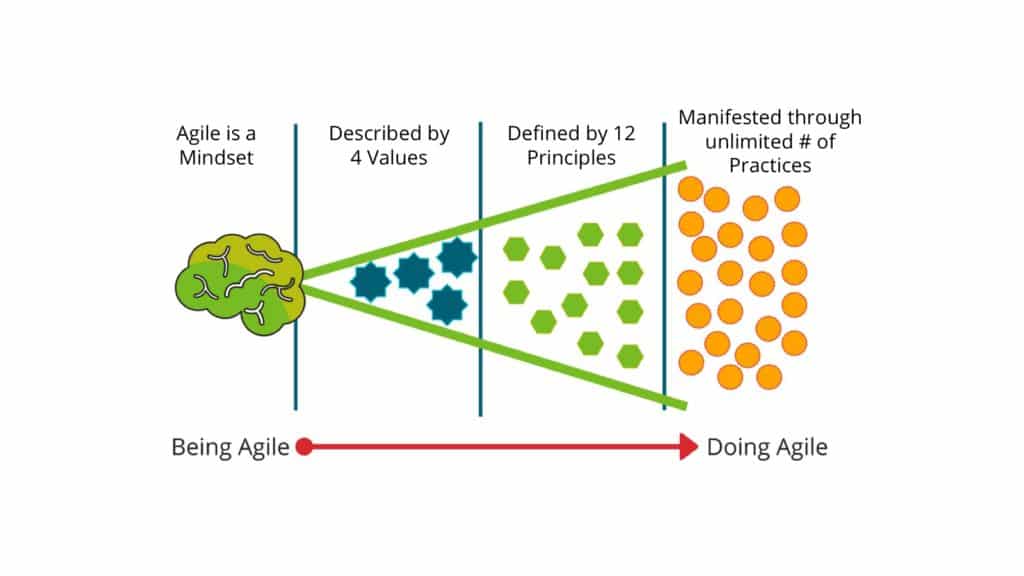
Agile Practices to Try
You’ll notice in that discussion of Agile values and principles that there was no mention of daily standup, kanban boards, or sprints.
Weird, right?
Actually it’s not, because while these and other well-known markers of Agile behavior are great, they aren’t the only way to do Agile.
It’s convenient for marketers to look at what software teams are doing and mimic them, but their practices don’t always translate to our work.
Based on the work I’ve done with Agile marketing teams and conversations with many advanced practitioners, I suggest you consider these four practices as your first stops on the road to agility:
- Build a backlog: This prioritized to-do list is the single point of truth for what the Agile marketing team works on next. Get good at keeping it current and navigating the politics of who gets to update it and when.
- Visualize your workflow: Consider where work comes from, what happens to it while your team is working on it, and where it goes after it’s done. Sketch it first, then draw up your first kanban board (as illustrated below).
- Apply WIP (Work in Progress) limits: Start experimenting with limits on how much work can be in each stage of the workflow at any given time. Check out this post for more on the powers of WIP limits and how to apply them.
- Hold daily standups and retrospectives: Start the continuous improvement process by getting the team together each morning to talk about their progress, and supplement those conversations with weekly retrospectives to drive process-related experiments.
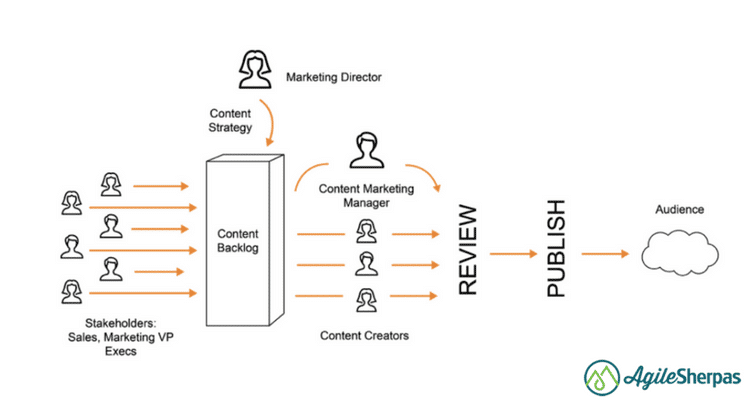
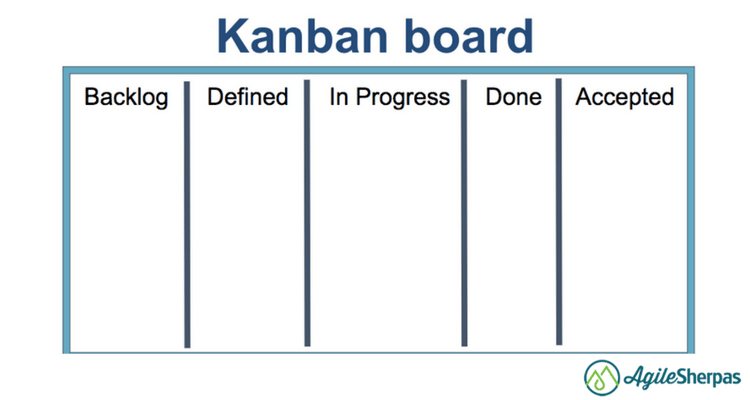
All the Agile Options to Get the Benefits of Agile Marketing
This is a major pet peeve of mine: don’t assume that Scrum = Agile. There are a nearly infinite number of Agile practices, some of which fall under the Scrumbrella and many of which don’t.
Limiting your options to Scrum isn’t helpful, so keep an open mind as you start your Agile transformation.
In fact, our most recent State of Agile Marketing report revealed that not only are most Agile marketing teams (54%) using a hybrid framework, this approach is more likely to deliver the benefits cited above:
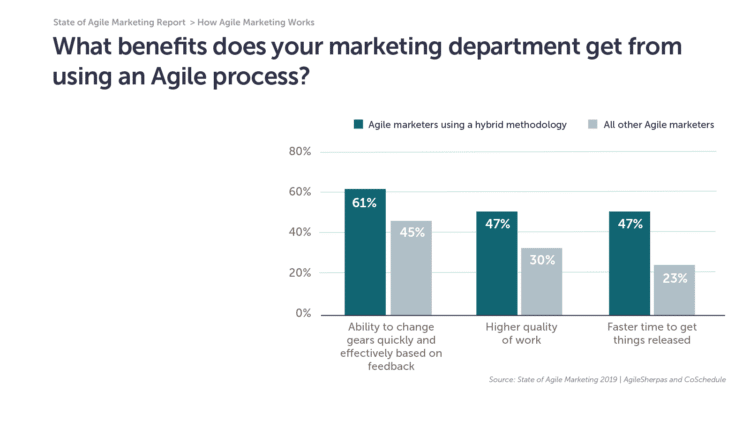
Agile Marketing Benefits Make Hard Choices Worth It
Speed, efficiency, professional satisfaction, and visibility into marketing’s work. And that’s just the tip of iceberg.
The list of benefits of agile marketing is long and varied, but hopefully this collection of hard data will help you when it comes time to choose between what is Agile and what is easy.

The post Benefits of Agile Marketing: Stats You Need to Know appeared first on AgileSherpas.com.






